The Convergent Evolution of Agriculture in Ants and Humans
Ted R. Schultz
Research Entomologist
National Museum of Natural History
Sponsored by a PSW Science Member who has asked to remain anonymous
About the Lecture
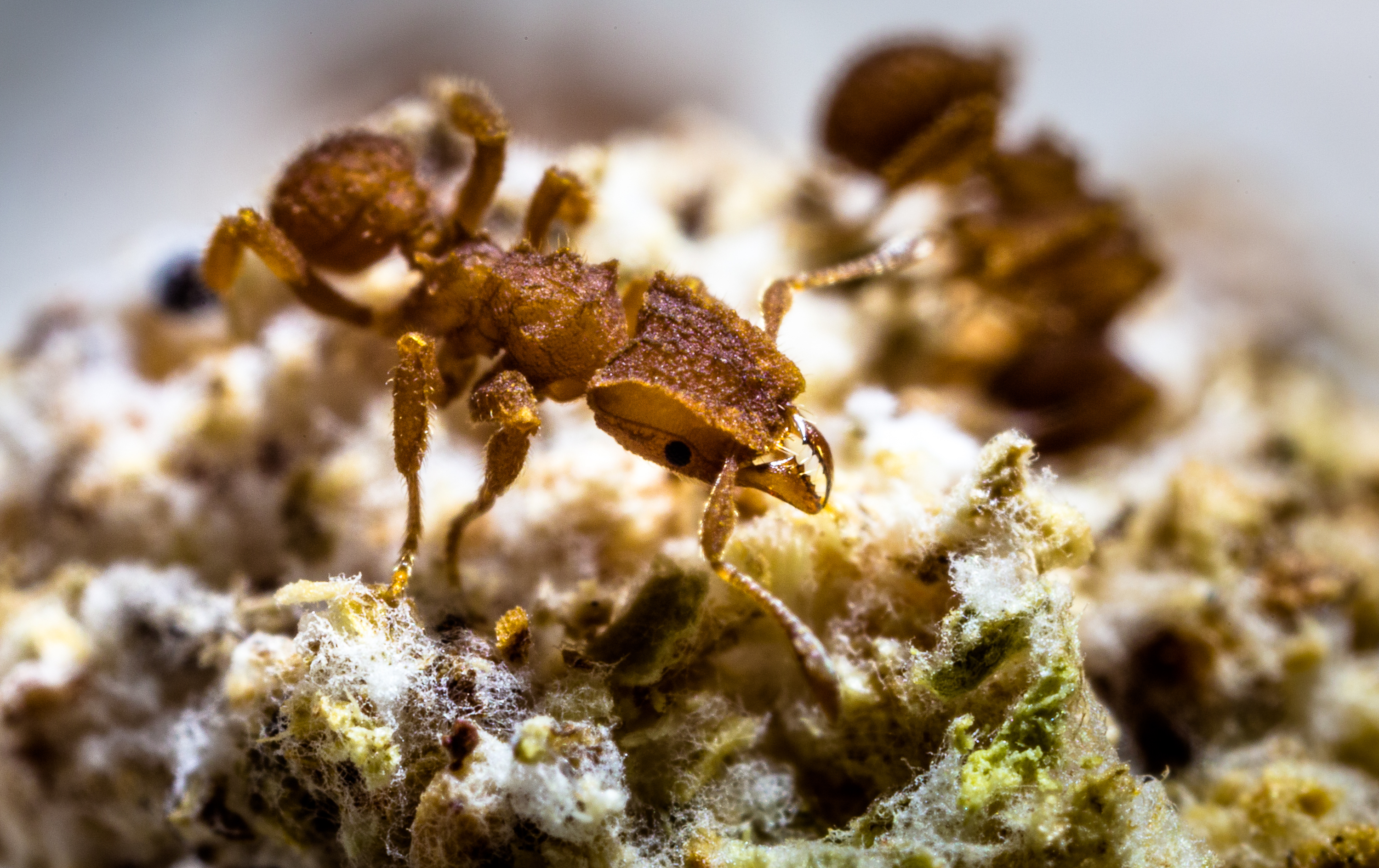
Agriculture is a particular form of mutualistic symbiosis. During the past 12,000 years, it has arisen in humans as many as 23 times. During the past 66 million years, it has also arisen in non-human animals at least 20 times and in insects at least 15 times, most notably in ants, termites, and ambrosia beetles. It is much more likely that these independent origins represent similar solutions to the challenge of growing food than that they are purely due to chance.
The lecture will focus on the most well-studied of the non-human systems, fungus-farming ants, a group of 251 species that occur only in North, Central, and South America and the Caribbean, with the highest concentration in tropical South America. The most familiar fungus-farming ants, leaf-cutting ants, have colony sizes of 5 million or more individuals and are the major herbivores of the Neotropics, and they are the most highly eusocial of all social insects.
Aside from a few species of leaf-cutting ants, which are major pests of human agriculture, the biology of the majority of fungus-farming ants is poorly known, as are the identities of the fungi that they cultivate. Thanks to intensive field work by a number of researchers during the past 35 years, and to recent advances in genome sequencing, this situation has begun to change.
The lecture will summarize the general biology of fungus-farming ants and their fungal cultivars, as well as of other microbial symbionts that are part of the system. The evolutionary histories of ants and fungi will be compared, with implications for reconstructing sequential ant-fungus coevolution. The many similarities between the origins and evolution of human and ant agriculture will be compared and discussed. For example, many of the fungi cultivated by ants appear to be capable of living freely apart from ants at no cost to their fitness, whereas other fungi appear to be unable to do so, suggesting a parallel with the domesticated cultivars of humans. In a parallel with modern industrial human agriculture, the agriculture practiced by leaf-cutting ants creates entire agro-ecosystems, strongly impacting local environments and supporting communities of thousands of species of animals, plants, fungi, and bacteria.
A better understanding of the evolutionary and ecological mechanisms that drive both human and non-human agriculture could lead to the improvement of human agricultural methods. Over vast time spans leaf-cutting ants have, after all, sustainably propagated a single, possibly asexual fungal species; managed an ever-present, evolving microfungal crop disease; and sustainably managed the trees and grasses on which they forage in their local environments.
Selected Reading & Media References
Schultz, Ted R., Richard Gawne, and Peter N. Peregrine, editors. 2022. The Convergent Evolution of Agriculture in Insects and Humans. Cambridge, Massachusetts: MIT Press, Vienna Series in Theoretical Biology, ed. G.B. Müller. 327 pp. [Peer-reviewed edited book.] https://doi.org/10.7551/mitpress/13600.001.0001
Mueller, U.G, N.M. Gerardo, D.K. Aanen, D.L. Six, and T.R. Schultz. 2005. The evolution of agriculture in insects. Annual Review of Ecology, Evolution, and Systematics 36: 563-595.
Schultz, T.R., U.G. Mueller, C.R. Currie, and S.A. Rehner. 2005. Reciprocal illumination: A comparison of agriculture in humans and ants. Pp. 149-190 in: Ecological and Evolutionary Advances in Insect-Fungal Associations (Fernando Vega and Meredith Blackwell, editors). Oxford University Press, New York.
Schultz, T.R. Fungus-farming ants (Attini in part). 2020. In: Starr C. (ed.) Encyclopedia of Social Insects. Springer, Cham, Switzerland. https://doi.org/10.1007/978-3-319-90306-4_46-1
Postigo, Julio C., and Joan E. Strassmann. 2022. “Animal agriculturalists.” Science 376 (6591): 359-359. https://doi.org/10.1126/science.abq2570. (Book review of The Convergent Evolution of Agriculture in Insects and Humans, T.R. Schultz, R. Gawne, and P. Peregrine, editors.)
Handwer, Brian. “Could Ants, Termites and Fishes Make Humans Better Farmers?” Smithsonian Magazine (online): At the Smithsonian. 17 May 2022. https://www.smithsonianmag.com/smithsonian-institution/could-ants-termites-and-fishes-carry-lessons-to-make-humans-better-farmers-180980085/
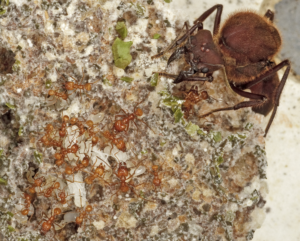
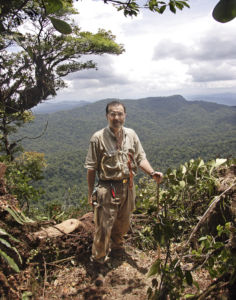
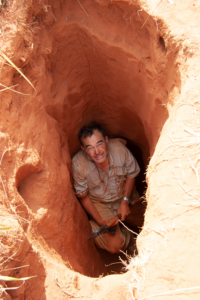
About the Speaker
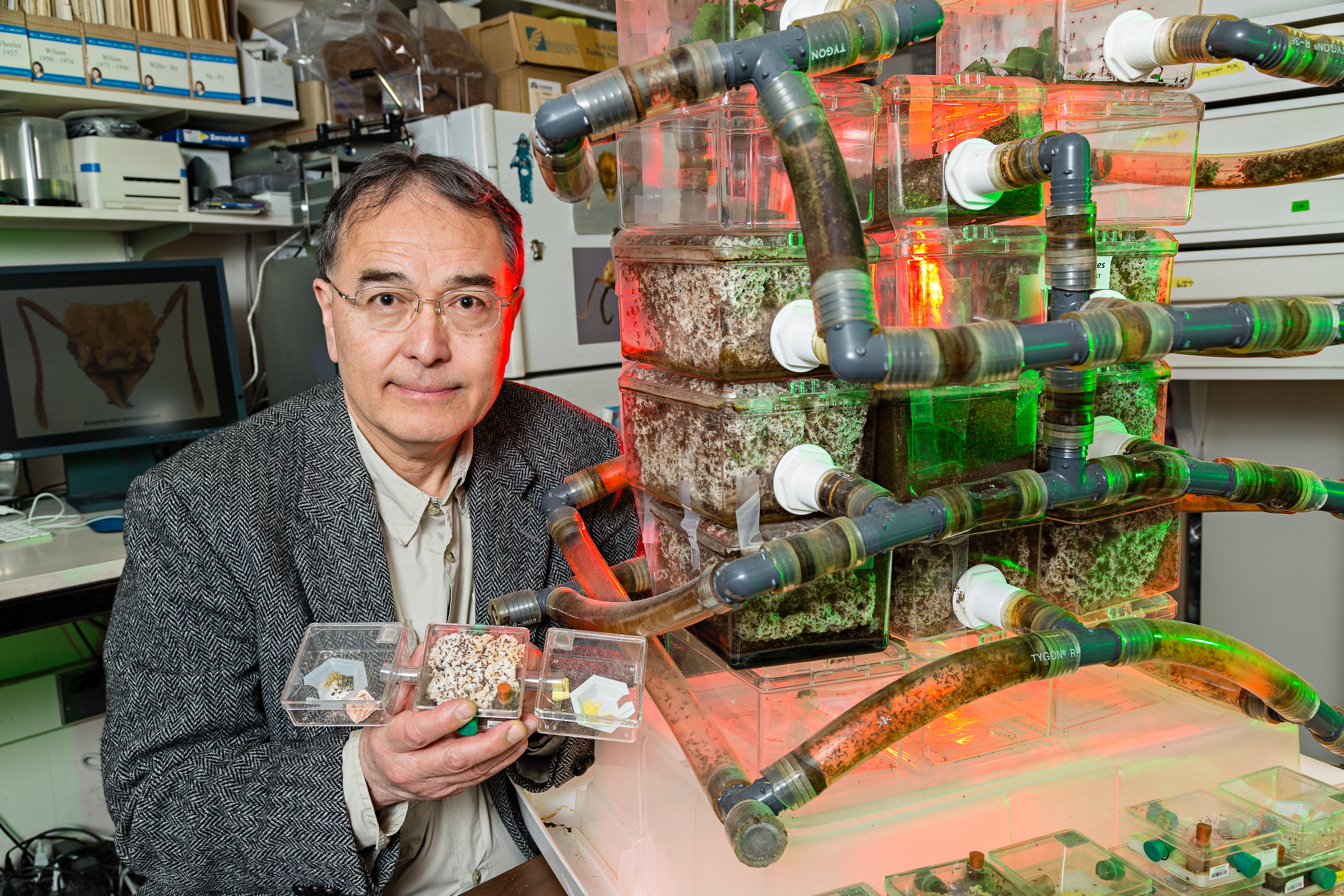
Ted R. Schultz is a research entomologist and former chair of the Department of Entomology in the Smithsonian Institution National Museum of Natural History, and he also is Adjunct Professor of Entomology at the University of Maryland in College Park. Before joining the Smithsonian he had a peripatetic working life, as a freelance writer, editor, copy editor, proofreader, graphic designer, illustrator, printer, newspaper and magazine production artist, artist, copy camera operator, jewelry maker, cab driver, bartender, dental technician, and dishwasher, among a variety of other jobs.
Ted’s research focuses on the evolutionary history of ants using phylogenomic and fossil data. His interests include all 15,000 extant ant species but he is particularly focused on a group of around 250 species that began farming fungi for food around 66 million years ago. His research has taken him on 32 field expeditions, excavating the nests of fungus-farming ants in 11 South and Central American countries, including 15 trips to diverse locations in Brazil.
He is author on over 120 publications and is an author or editor of four books, including (with Gawne and Peregrine) The Convergent Evolution of Agriculture in Insects and Humans (MIT Press). He also is the author of The Fringes of Reason: A Whole Earth Catalog of New Age Frontiers, Unusual Beliefs, and Eccentric Sciences (Crown/Harmony Books). Ted has appeared in a number of nature documentaries including Evolution: A Journey to Where We’re From and Where We’re Going (WGBH/NOVA and Blue Sky Productions). While at the Smithsonian Ted served on the core design teams of the exhibits, “Partners in Evolution: Butterflies and Plants” and “Farmers, Warriors, Builders: The Hidden Life of Ants”.
Among other honors and awards, Ted has been elected as a Fellow of the American Association for the Advancement of Science.
Ted earned a BS in Biology at UC Berkeley, and a PhD Entomology at Cornell University.
Minutes
On Friday November 3, 2023, in the Powell Auditorium of the Cosmos Club in Washington, DC and by live stream to the PSW Science YouTube channel, President Larry Millstein called the 2,484th meeting of the Society to order at 8:03 PM Eastern Time. He welcomed attendees, thanked sponsors, and announced new members. The minutes of the previous meeting and the lecture by Prineha (Pri) Narang on Non-Equilibrium Quantum Mechanics. The minutes were accepted by vote of members attending without correction or comment.
President Millstein then introduced the speaker for the evening Ted Schultz for his talk on the Convergent Evolution of Agriculture in Ants and Humans. Schultz' lecture was a comprehensive overview of the complex world of fungus-farming ants, highlighting their evolutionary history, the intricacies of their agricultural practices, and the broader implications of these studies for understanding the nature of agriculture as a symbiotic relationship in both human and non-human species.
Schultz began by explaining that mutualism is a biological interaction where both participants benefit, in contrast to parasitism, where one participant suffers. Agriculture, both in humans and non-humans, he said, is an example of mutualism. Human agriculture, he pointed out, has independently originated around 23 times, covering a variety of crops. And in non-humans, he said, it has arisen in a diverse variety of organisms, including damselfish, snails, polychaete worms, and fungus-farming termites, beetles, and ants.
The speaker said that he would focus the talk on the fungus-farming ants. These farmers, he said, are found exclusively in the New World, where they have developed a highly sophisticated agricultural system. The well-known leaf-cutting ants from the genus 'Atta' are capable of building large, complex nests with thousands of garden chambers, he pointed out. He likened these nests to superorganisms due to their scale and complexity. Interestingly, he said, these ants do not consume the leaves they harvest directly but instead use them to cultivate a fungi they feed on.
Schultz discussed the complex process of cultivating the fungus gardens. He explained that the process includes foraging for suitable organic substrates, preparing and incorporating these substrates into the garden, and caring for the garden by adding healthy mycelium and manuring them with fecal droplets. Only this meticulous care by the ants ensures health and productivity of the fungal cultivar that they depend on for their sustenance, he pointed out.
The first detailed accounts of leaf-cutting ants were provided in the 19th century by naturalists Henry Walter Bates, Thomas Belt, and Fritz Mueller. Their observations and discoveries laid the groundwork for understanding ant agriculture. Belt in particular discovered that ants use leaves as a substrate to grow fungi, a groundbreaking revelation at the time.
Schultz then discussed another interesting aspect of ant agriculture: crop diseases, particularly susceptibility of the leaf cutter fungus to the parasite Ascomycete escovopsis, which competes with the ants for the fungal cultivar. The competition has prompted the ants to cultivate on their own bodies an actinomycete bacteria that produces antibiotic substances that control the escovopsis parasite. The interactions constitute a complex four-part symbiosis involving the ants, their fungal cultivars, antibiotic-producing bacteria, and the escovopsis parasite, he said.
Schultz also discussed the phylogeny and evolution these ants and their fungal cultivars. Despite efforts spanning over a century, constructing phylogenetic trees for these organisms has been challenging, he said. Early attempts were limited in scope, but with the advent of molecular systematics and phylogenomic markers like ultraconserved elements (UCEs), more accurate and comprehensive phylogenies have been developed. These phylogenies reveal patterns of co-diversification among ants, their cultivars, and parasites like escovopsis, he said.
These studies have also uncovered intriguing patterns within ant agriculture systems. For instance, he said, while broad phylogenetic groups of ants tended to cultivate specific groups of fungi, there were instances of horizontal transfer where ants acquired cultivars from other nests or from free-living fungi. These transfers occurred in a variety of situations, he said, such as when a colony's garden died or a daughter queen failed to bring a fungal sample from her mother's nest.
Schultz said that one of his key research priorities is identifying rare fungus-farming ant species with the potential to provide insights into the evolution of ant agriculture. This research is particularly urgent, he said, given the rapid destruction of natural habitats. Among interesting discoveries that provide such insights he cited the genus Mycetogrus, discovered in 2001, which has deep garden chambers and cultivates lower fungi and Paramicophylax bruchi, a sister species to yeast farming ants,. Another surprising discovery, he said, was Apterostigma mease, which is unique among lower fungus farming ants for cultivating a higher fungal cultivar, Leucoagaricus gongylophorus. The finding suggested the existence of unknown biological mechanisms that typically constrained agricultural systems within fungus-farming ants.
Schultz concluded by drawing parallels between human and non-human agriculture, emphasizing that both are forms of symbiosis. He pointed out that the emergence of agriculture in human societies, as in ants, involved a series of evolutionary steps, including modifying local environments, engaging in incidental cultivation, and eventually domestication and the formation of complex societies. He suggested that these parallel evolutionary pathways in humans and ants were not coincidental but rather examples of convergent evolution, driven by the limited ways in which organisms can develop agricultural systems.
Following the lecture there was a Question and Answer period.
One questioner asked: Are there poachers in the animal world who would go and either eat the fungi that are produced or farmed by the ants or take the advantage of seeing the fungi and eat the ants such as the ant eaters? Schultz replied that, yes, there are animals that specialize in preying on ants. For instance, some poison dart frogs consume ants and may derive certain chemicals from them for their toxins. Anteaters are another example; they target large leafcutter ant nests. There are arthropods and other creatures that inhabit the waste chambers of ant colonies, but not many that specifically take advantage of the fungus gardens.
Another questioner asked: Has there been any attempt to grow ant-cultivated fungi in a controlled environment, and has it been successful? Yes, Schultz said, there have been efforts to culture ant-cultivated fungi in controlled environments. Researchers have designed methods to maintain fungus farming ant colonies in the laboratory for extended periods. They have also managed to isolate the fungi from the gardens and grow them in sterile culture. This allows for studying the ant-fungus symbiosis in a controlled setting. It has been relatively successful, and ant-farming ants can be cultured in the lab for years, facilitating research on their behavior and interactions with the fungi.
Other questions included the following.
Q: Is there a possibility that closely related fungi could turn into yeast when introduced to yeast-growing ants? A: While it's an intriguing idea, there hasn't been specific research conducted on whether closely related fungi can turn into yeast when introduced to yeast-growing ants. However, such experiments could provide valuable insights into the flexibility and adaptability of these ant-fungus relationships.
Q: Do ants exhibit consciousness? A: The question of consciousness in ants is a complex and debated topic. Ants do exhibit sophisticated collective behaviors and can respond to various stimuli, both internal and external, in coordinated ways. However, their behaviors are primarily the result of decentralized interactions and chemical signaling, rather than individual consciousness as humans experience it. Ant colonies display emergent properties where the colony as a whole acts as a superorganism, but it's not clear whether individual ants possess consciousness in the human sense.
Q: How do ants contribute to the soil health in ecosystems where they are present? A: Ants can influence soil health in various ways. They excavate soil while constructing nests and chambers, which can improve soil aeration and drainage. They also bring organic matter into their nests, which decomposes and enriches the soil. In tropical ecosystems, leafcutter ants, for example, process massive amounts of vegetation, which further contributes to soil nutrient cycling. However, the extent of their impact on soil health depends on factors like ant species, local conditions, and the composition of the ecosystem.
Q: What is the difference between high agriculture and low agriculture in the context of ant-fungus symbiosis? A: In the context of ant-fungus symbiosis, "high agriculture" refers to the practice of cultivating higher fungus species, primarily basidiomycete mushrooms, by certain ant species. These ants actively cultivate, protect, and consume the fruiting bodies (mushrooms) produced by the fungus. "Low agriculture" refers to ant species that cultivate lower fungus species, primarily ascomycete fungi, in their underground gardens. The key difference lies in the type of fungus cultivated, with higher agriculture involving mushrooms and lower agriculture involving non-mushroom-forming fungi.
Q: Do ants actively select for better fungal species? A: While ants play a role in promoting the growth and maintenance of their cultivated fungi, it's not entirely clear whether they actively select for better fungal species. Ants do engage in behaviors that promote the health and growth of their fungal gardens, such as weeding out competing fungi and tending to the gardens. However, the extent of their role in fungal species selection and whether artificial selection occurs are still areas of research and debate.
Q: Is there evidence of selection of fungal species by the ants? A: There is some evidence that ants may select for specific fungal species or strains that are better suited to their mutualistic relationship. However, the exact mechanisms and extent of selection are still being studied. Ants are known to actively tend to their fungal gardens, removing unwanted fungi and promoting the growth of preferred species. This behavior suggests a form of selection, but more research is needed to understand the full scope of this process.
After the question and answer period President Millstein thanked the speaker and presented him with a PSW Ribbon, a signed copy of the Volume 1 of the Bulletin of the Philosophical Society, and a framed announcement of his talk signed by all the members of the General Committee on behalf of the members.
President Millstein then announced up-coming lectures, made a few house-keeping announcements, thanked the evening's volunteers and, at 9:52 PM, adjourned the meeting to the social hour.
Attendance the Powell Auditorium: 44
And on the YouTube live stream: 29
For a total in person attendance of 73
Views of the video recording in the 2-week period after the lecture: 440
Temperature at the Powell Auditorium - 8°C
Weather - Partly cloudy
Respectfully submitted,
Larry Millstein
on behalf of Recording Secretary Cameo Lance